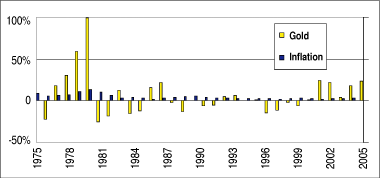Is Gold A Hedge Against A Falling Dollar?
by John L. Momsen
Access to foreign exchange trading has opened up exciting trading options for the retail trader. You can now trade alongside corporations and institutions in a highly liquid market that is global, traded around the clock, and highly leveraged. Before jumping into this market, however, we must understand the factors that affect the forex market. With that in mind, STOCKS& COMMODITIES has introduced Forex Focus to better prepare the retail trader to participate in the currency market.
Is gold the great investment it's said to be? Let's take a look.
The other day I turned on the radio to listen to my favorite radio show. It was still a bit early, so airing was an advertisement for one of those "gold investment" firms. Lately, they seem to be all over radio and television. So I listened to what the ad had to say, which basically was, "Gold is a hedge against inflation! Gold is a hedge against a falling dollar! Gold offers terrific profit potential and appreciation!"
What I heard was normal advertising rhetoric. However, since I have an affinity for the gold market (we both began trading on the futures exchanges at about the same time) and have always been interested in researching various investment vehicles, I decided to investigate the ad's claims.
Gold began to trade on the American futures exchanges in late 1974, so I used data on spot gold from the December 31, 1974, close through the August 31, 2006, close. The period of nearly 32 years of data spanned enough time periods for me to get a true research picture on the claims in the advertisement.
SPOT GOLD VS INFLATION
First, I decided to investigate the claim that gold is a hedge against inflation. A hedge can be considered to be something that protects you against a financial loss. Simply stated, this means that gold will increase at or above the rate of inflation, thus protecting the buying power of your investment.
I decided the best way to present the results of this research would be to copy the way mutual funds present their historical results: one-year, three-year, five-year, 10-year results, and since inception. I decided to go one step further and show not just one static date but rolling periods, as you will see in Figures 1, 2, 3, and 4. Thus, in the 10-year graph you will see 23 10-year periods beginning with 1975-84 and ending with 1997-2006 (August 31, 2006, actually). The same is true for the three- and five-year graphs. Of course, the one-year graph is just that, a one-year period.
If you look at Figure 1 you will see that on a year-to-year basis, the price of spot gold rose more than that year's inflation. In the 32 one-year periods, gold beat inflation 14 times (43.8%) and lost to inflation 18 times (56.2%). This is not a good showing. On the other hand, many investments lose to inflation during short periods of time. I expected that as the number of years in the time periods increased, the number of times gold would beat inflation would increase.

FIGURE 1: SPOT GOLD PRICES VS. INFLATION. In the 32 one-year periods since gold began trading on the American futures exchanges, it has beaten inflation on a year-to-year basis 14 times or 43.8%.
Return to February 2007 Contents
Originally published in the February 2007 issue of Technical Analysis
of STOCKS & COMMODITIES magazine. All rights reserved. © Copyright
2007, Technical Analysis, Inc.